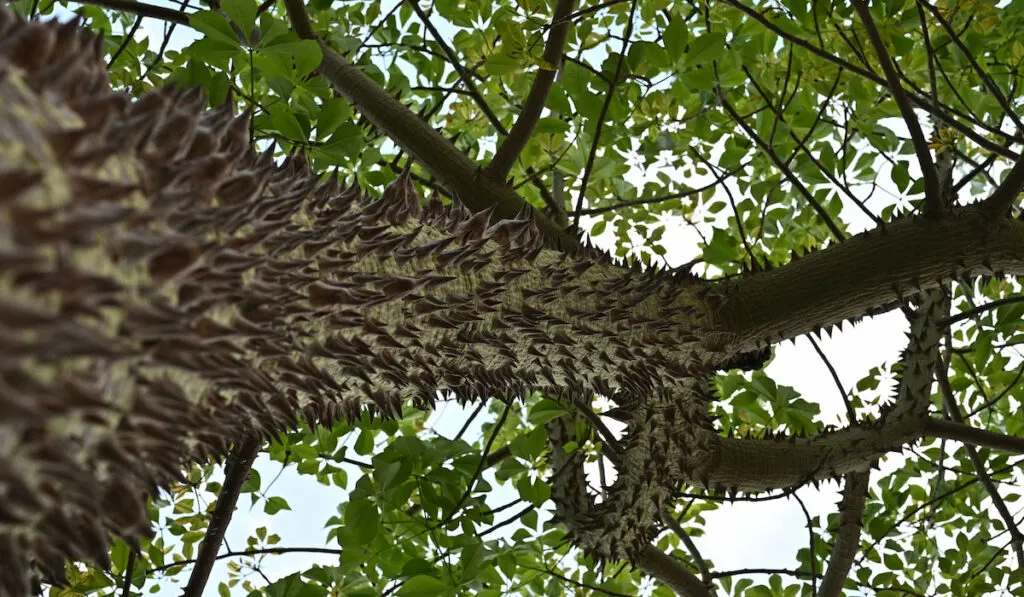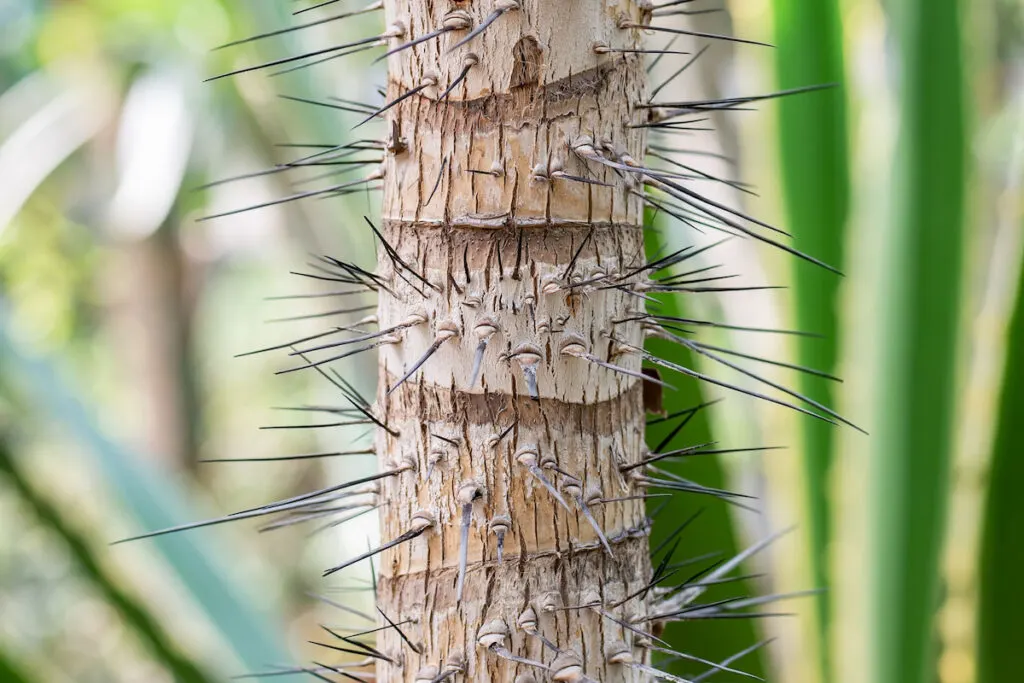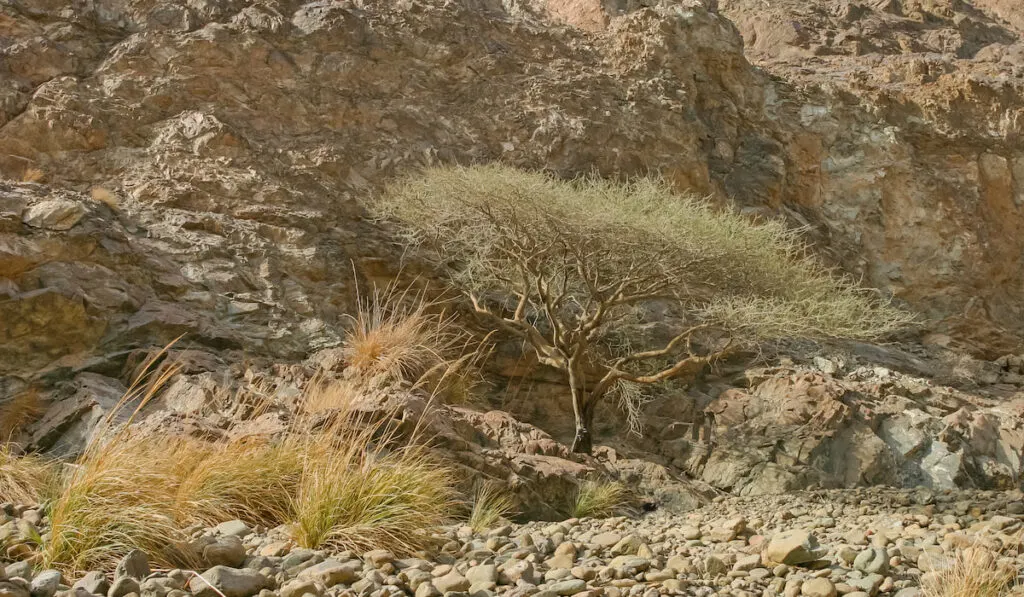Have you ever sat or stood near some trees only to find some spiny structures suddenly poking your hands or part of your body? And the lingering pain you felt made you feel that this phenomenon was just an anomaly that happens only with that one tree you encountered? Believe it or not, some trees do have spikes on their trunks.
Some people tend to look at spiky trees as nuisances. They aren’t human-friendly, are hard to touch, and can be dangerous to plant near their homes. But nature has its reasons for providing these trees with this specific trait.
Spikes on tree trunks act as a defense mechanism for the plant to deter herbivore predators and the danger that lurks around them. Nature lovers appreciate the diversity of every tree species and tend to do their best to preserve these spiky trees from becoming extinct.
This article will focus on some tree species with spikes on their trunks. After reading this article, you’ll realize the uniqueness of this type of tree.
Table of Contents
1. Coral Tree (Erythrina sp.)

Coral trees originated from South America and South Africa. These spiky deciduous trees can be recognized by their stems, branches, and a trunk full of spikes, dark green leaves, and red flowers that bloom in late winter. Most parts of these plants are poisonous except for the spines.
There are a few varieties of coral trees, such as the common coral tree (Erythrina crista-galli), the Indian coral tree or tiger’s claw (Erythrina variegate), and the red bean tree (Erythrina corallodendron)
Coral trees typically grow between 35 and 45 feet tall and can reach up to 60 feet tall. They spread between 10 and 15 feet wide with high tolerance to different soil acidity levels.
These medium to large-sized trees grow in USDA hardiness zones 9 to 11. They also love moist, well-drained soil and prefer to grow under full sun.
2. Silk Floss Tree (Ceiba speciosa)

These exotic trees hailed from South America’s tropical and subtropical regions, particularly in Brazil, Paraguay, and Argentina.
They are also known as Palo borracho (which means “drunken stick” in Spanish), paineira, and toborochi (tree of refugee). Silk floss trees generally grow around 60 feet tall and spread around 30 feet wide.
These large deciduous trees possess grayish green trunks covered with non-poisonous spikes, dark green leaves, pear-shaped seed pods, and pink flowers that bloom in fall. They thrive in the hardiness zones 9 to 11 and prefer well-drained, moist soil.
Silk floss trees can grow under full sun and have a high tolerance to drought and hot environments. Conversely, they don’t grow well in wet and cold regions.
3. Hercules’ Club (Zanthoxylum clava-herculis)
Hercules’ club trees can be commonly found in their native habitat in the southeastern United States. They are also called southern prickly ash and pepperwood trees.
These medium to large-sized trees usually grow between 36 and 72 feet tall. They are easily distinguished by their light silvery spiky trunk, dark green foliage, black seeds, and clusters of yellowish green flowers in spring.
Hercules’s club trees attract a few different birds and insects, such as leaf beetles and butterflies. They thrive in dry soil and prefer to grow under full sun.
Another variety of the same species, Zanthoxylum americanum, is commonly known as the toothache tree. Back in the old days, these trees were used to treat toothache and gum pain.
4. Wild Apple Tree (Malus sp.)

These small to medium-sized trees are native to Kazakhstan, Uzbekistan, Tajikistan, and Central Asia. They are commonly known as the crabapples and thrive in hardiness zones 4 to 8.
Wild apple trees can grow up to 33 feet tall. They might look similar to domestic apple trees with dark brown stems and bark, whitish pink flowers, green ovate flowers, and greenish-yellow fruits.
Typically, these trees only grow spikes when they are fully mature. However, other species, such as the European wild crabapples (Malus sylvestris) that originated from the United Kingdom and Ireland, possess more thorns on their trunk and branches.
This is the result of crossbreeding between wild crabapples and domestic apple trees.
5. Sandbox Tree (Hura crepitans)

Originating from North and South America, these Amazonian trees thrive in hardiness zones 10 to 11 and could grow up to 130 feet tall. They are also known as the monkey’s pistol trees, “monkey-no-climb” trees, possumwood, and monkey’s dinner bell trees.
The sandbox trees can be recognized by their spiky trunk, dark green heart-shaped leaves, and pumpkin-shaped fruits.
There are a few reasons why these large tropical trees are considered dangerous. It isn’t because of the spikes found on their trunk, but their latex or sap that’s highly toxic.
The sap can cause red rashes on the skin and induce blindness, vomiting, cramps, and even diarrhea if ingested.
It is one of the reasons why the Amazonian people used latex extracted from these trees to make poison darts. Furthermore, the fruits can also explode and cause injuries to animals or humans nearby.
6. Aiphanes minima (Guinea bactris)

Aiphanes minimas are native to the Caribbean, specifically Puerto Rico, Grenada, Barbados, and the Dominican Republic. These unique palm trees are covered with long, sharp black spikes all over their trunk and stems. They are also known as the Macaw palms, coyore, and grigri.
Aiphanes possess bright green pinate leaves, yellowish cream-scented flowers, and bright red fruits that measure around 0.1 inches long. The flowers usually attract insect pollinators such as bees.
These trees love moist, well-drained soil and can tolerate partial or full sun. They can grow up to 60 feet tall and are mostly grown as ornamental plants. They usually thrive in the USDA zones 10a to 11.
7. Honey Locust (Gleditsia tricanthos)

Honey locust trees are one of the well-known large, deciduous trees native to central and eastern North America. In the United States, they are commonly found throughout North Carolina, Nebraska, Texas, Kentucky, and Pennsylvania.
They are also called thorny honey locusts, honey shuck locusts, and sweet bean trees. This medium to large-sized deciduous trees can be distinguished by their non-poisonous spiky trunk, green pinnate leaves that turn yellow in fall, whitish cream flowers that bloom in late spring, and dark brown seed pods.
Honey locust trees generally grow between 60 and 80 feet with the same spread. They thrive in hardiness zones 3 to 8 with high tolerance to different types of soil.
These trees are also sturdy and robust and can withstand strong wind, drought, and even attacks from animals such as deer.
8. Devil’s Walking Stick (Aralia spinosa)

Due to having the same alternate name, “Hercules’s Club,” these trees are commonly confused with Zanthoxylum clava-herculis. But they aren’t related to one another.
These trees are also known as the Angelica trees, prickly elder trees, and prickly ash trees. Aralia spinosas are native to southeast North America.
They can be recognized by their bipinnate green leaves, dark brown spiky trunk and stems, clusters of whitish-green flowers, and purplish-blue fruits or berries. These small to medium-sized trees generally grow between 10 and 15 feet tall.
In some cases, they also could reach up to 35 feet tall. Aralia spinosa thrives in hardiness zones 4 to 9 and tolerates different soil types.
However, they thrive in slightly acidic, moist, and well-drained soil. They can also tolerate partial or full sun.
9. Umbrella Thorn Acacia (Acacia tortilis)

The umbrella thorn acacias are native to the Middle East and Africa. They are also known as the Israeli babool and acacia faux gommier.
Growing in hardiness zones 10 to 12, these small to medium-sized trees can be distinguished by their long and sharp non-poisonous spikes all over their branches and stems, dark green compound leaves, whitish cream scented flowers that bloom in summer, and dark brown seed pods.
When fully mature, umbrella thorn acacias grow between 13 and 26 feet tall. In some cases, they could also reach up to 65 feet tall. These trees can thrive in arid or semi-arid regions.
They also love alkaline soil and being exposed to full sun. Due to their large and wide crown, these trees provide ample shade for birds and animals in their habitat.
10. Kapok Tree (Ceiba pentandra)

These towering and large trees originated from tropical regions, particularly in Central America, South America, Mexico, and West Africa. They generally thrive in the hardiness zones 10 to 12 and grow between 100 and 130 feet tall.
In some cases, they could reach as high as 200 feet. Kapok trees are also known as silk-cotton trees, Java cotton trees, samauma, and Java kapok trees.
They are easily recognized by their thick trunk full of non-poisonous spikes, thorny branches, palm-like green leaves, oblong-shaped green fruits, and scented summer flowers that come in different colors, such as white, yellow, and pink.
The flowers are usually pollinated at night by nocturnal animals such as bats. These trees also love moist, well-drained soil and enough exposure to full sun.
Final Thoughts
All of the species listed above aren’t as harmful or useless as they might seem. Some of them provide fruit and food for animals and other critters. And the ones with sturdy, strong bark can be turned into high-quality timber for woodwork and housing. Like most trees, they are also one of the most significant regulators of a healthy environment and sustainable living on Earth.
Resources
- https://www.gardeningknowhow.com/ornamental/trees/coral-tree/coral-tree-information.htm
- https://www.gardenia.net/plant/erythrina-crista-galli
- https://www.thespruce.com/growing-silk-floss-trees
- https://www.gardeningknowhow.com/ornamental/trees/silk-floss/floss-silk-tree-planting.htm
- https://en.wikipedia.org/wiki/Zanthoxylum_clava-herculis
- https://www.nababutterfly.com/hercules_club.html
- https://www.wildflower.org/plants/result.php?id_plant
- https://globaltrees.org/threatened-trees/trees/wild-apple/
- https://homeguides.sfgate.com/crabapple-trees-thorns
- https://www.gardeningknowhow.com/ornamental/trees/sandbox-tree/sandbox-tree-information.htm
- https://onszaden.com/hura_crepitans
- https://www.palmpedia.net/wiki/Aiphanes_minima
- http://idtools.org/id/palms/palmid/factsheet
- https://www.florida-palm-trees.com/macaw-palm-tree/
- https://plants.ces.ncsu.edu/plants/gleditsia-triacanthos/
- https://www.gardenia.net/plant/gleditsia-triacanthos
- https://mortonarb.org/plant-and-protect/trees-and-plants/devils-walking-stick/
- https://blog.wfsu.org/blog-coastal-health/2021/07/devils-walkingstick-your-new-favorite-thorny-pollinator-plant/
- https://www.krugerpark.co.za/africa_umbrella_thorn.html
- https://www.feedipedia.org/node/339
- https://www.missouribotanicalgarden.org/PlantFinder/PlantFinderDetails
- https://candide.com/ZA/plants/
